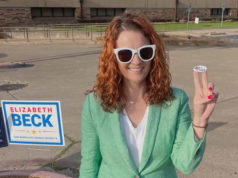In 2011, Fort Worth Weekly ran a story about K2, the common name of a type of designer drug marketed by head shops as a legal alternative to marijuana. During the course of researching the story, a reporter asked several employees at the Weekly to sample the drug to see how it compared to the real deal.
One employee, who asked that his name not be used for this story, reported that what started as a fun experiment played out like a nightmare.
He used a small amount of the drug in his backyard. After hallucinating the images of people hiding in his bushes, he started to hear whispering voices. He felt paranoid, convinced that his neighbors had “called the feds” on him.
“I got in the shower,” he said. “I could still hear the whispering voices, so I lay down in a fetal position for at least 45 minutes.” After a couple of hours, the drug wore off.
As it turns out, the Weekly employee got off easy.
Since the emergence of its first version a few years ago, the drug commonly known as K2 has been linked to seizures, kidney failure, psychotic episodes, and even death. The drug’s recipe has changed so many times, scientists don’t even call it K2 anymore — they refer to it as synthetic cannabanoids. Every time the Drug Enforcement Administration uses its special temporary powers to outlaw one of the drug’s ingredients, the manufacturers change the formula. The result is a trash-can punch of unregulated, often unidentified drugs made in clandestine labs (mostly in China) hitting the streets here in the United States.
Scientists are still in the dark as to exactly how the K2-type drugs affect the body. Drug enforcement officials are locked in an ongoing chess match with the manufacturers to figure out what’s in it. K2’s critics hope that recently passed legislation may close the loopholes that allow manufacturers to skirt the law by formula-changing, but questions remain as to whether the new law will hold up in court.
Despite the scary reports and growing concern in the scientific and drug enforcement communities, two local therapists who counsel teen drug abusers said K-2 drugs are just as popular as ever among teenagers.
Sierra Neuharth, a therapist at the Excel Center, an outpatient mental-health center in downtown Fort Worth, said her high school-age patients still think the drug is another type of marijuana and have a cavalier attitude about using it.
“If they can get hold of a type of marijuana that’s legal and doesn’t show up in a lot of drug tests, then that makes it more attractive to them,” she said.
But she and other therapists have seen a darker side of the drug.
“Kids become psychotic; they have audio and visual hallucinations,” she said. “I’ve had kids who have had command hallucinations: After they smoked K2, they heard voices telling them to hurt themselves or to hurt others.
“I’ve had kids — when they talk, it’s completely disorganized, and they don’t make sense,” she said. “They can’t connect words to make sentences.”
One of the major concerns of the scientific and medical community is that a person’s brain can be permanently fried after only one use.
“To be honest it’s scary,” said Neuharth. “You don’t know what to expect from kids coming in with a history of using K2. You don’t know what symptoms they are going to have, and that’s what makes it scary because sometimes it can be so severe.”
The scientific and drug enforcement communities often have no idea what compounds are in the drug. The latest iteration barely resembles the version that first hit the streets in 2010.
Marilyn Huestis, chief of chemistry and drug metabolism for the intramural research program at the National Institute on Drug Abuse, a program of the National Institutes of Health, said it is no longer accurate to call the drug K2.
“We really need to be calling them synthetic cannabinoids,” she said. “K2 and ‘spice’ [another common name for the drug] are referring to compounds that were available years ago, and they’ve been replaced as quickly as the drug enforcement agency identifies the [ingredient].”
The drug affects the same part of the brain as THC, the active ingredient in marijuana. But Jeffery Moran, chief of the environmental chemistry branch at the Arkansas Department of Health, said that characteristic is about the only similarity between K2 and marijuana.
“Toxicologically speaking, they are very different,” he said. “[K2] is much more potent and much more dangerous.
“THC is considered a partial agonist of the brain receptor; it only partially activates the psychological response of loving everyone and getting hungry,” he said. “The synthetic cannabinoids are characterized as full agonists. And full activation of that receptor takes you to a more extreme high, and that’s when you start seeing more toxic episodes: hallucinations, freaking out.”
Moran said the high is more comparable to methamphetamine than to marijuana.
Odette Tomlinson, another therapist at the Excel Center, said she has seen a marked difference between patients who abuse marijuana and those who use K2.
“In my experience, adolescents report [a high number] of anger outbursts, aggression, increased paranoia, physical complaints — chest pains, increased heart rate — and psychotic episodes while high on K2,” she said. “In many cases, patients continue to struggle with paranoia and disorganized thinking long after the drug is out of their system.”
Moran said he has detected close to 30 different kinds of synthetic cannabinoids being used in what is sold as K2.
“These drugs are mixed and matched in the final product in almost random combinations and dosages,” he said.
In July, President Barack Obama signed a law that essentially makes all synthetic marijuana compounds illegal. Congress tucked the provision into a bill that is now the Food and Drug Administration Safety and Innovation Act.
The clandestine labs, Huestis said, “are hoping these compounds may not be covered under the [new] law. And the truth is we don’t know yet, because it hasn’t had a lot of tests in the court system to determine whether or not this law is going to be upheld.”
Huestis and her team have access to drugs seized by the DEA, but she can’t yet ethically test them on people until she has a better understanding of the basic toxicology involved. That will come from experiments like the one in which she incubates the drugs with human liver cells to see how they metabolize. Depending on what those and other experiments show, she might be able to start testing on humans next year.
“Our goal with the human studies is to understand the entire pharmacology of this class of the drug,” she said, “what they do, how they do it, what the mechanisms are, what they are doing in the brain, heart, and kidneys. How does it affect someone’s ability to drive? To think and process? We’ll look at everything.”
In Arkansas, where Moran is on the front line of efforts to understand and contain the drug, the state created what he calls an expedited function, “so when we have a new emerging substance here in the state, our public health officer has a [faster] pathway to regulate things.
“What I’m trying to do is just get the drugs off the street,” he said.













